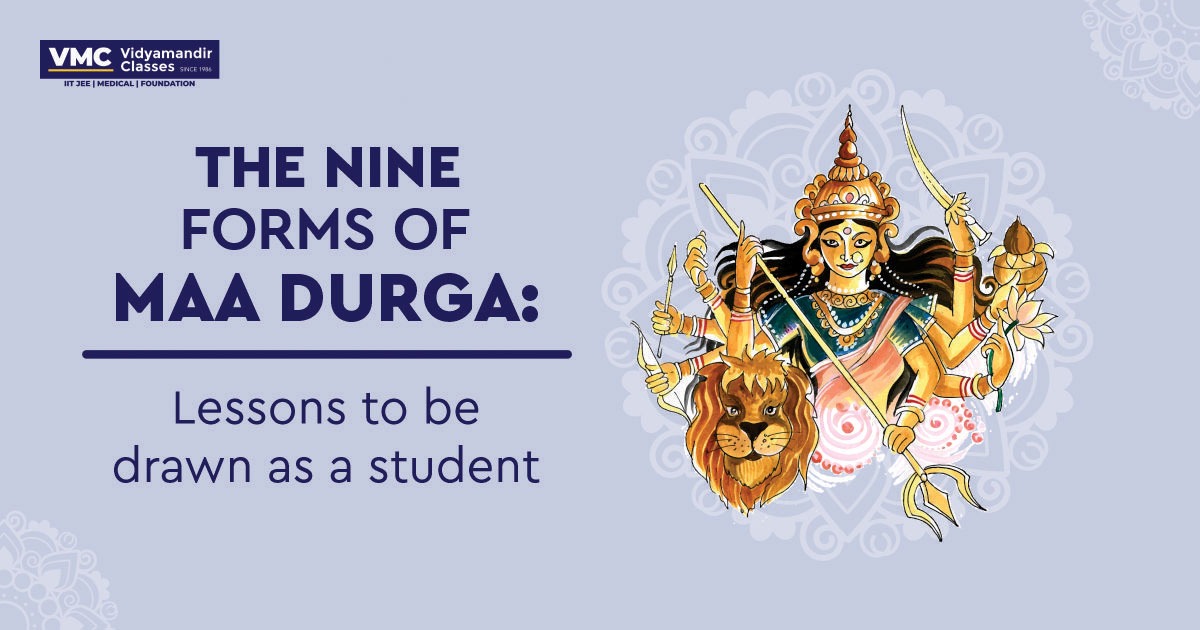The nine forms of Maa Durga: Lessons to be drawn as a student
 Posted On
Posted On
1,202 total views, 1 views today
All the nine forms of Maa Durga embodies distinct qualities, unitedly called ‘Navdurga’. Apart from celebrating the nine manifestations of Goddess Durga, people also honor the mother divine especially during Navratri and Durga Puja. Dev Shakti (where, Shakti = Energy) is the primal source of hidden energy that sustains this universe. The Dev Shakti exhibits itself in many shapes. It embraces qualities like strength, power, anger, beauty, compassion, including others. If these qualities put in optimal use by an individual, it can bless their lives with success and happiness in abundance.
The first form of the Mother Divine: Shailaputri
Shail denotes mountain, and Goddess Durga is called the daughter of the peak or the Mountain King. That said, the energy can only come to the realisation when it is at its highest peak, probably only then one can experience complete consciousness. Goddess Shailputri is the embodiment of love, strength and power. She guides us on the journey of rediscovering ourselves. As students, it’s extremely important for you to introspect and better yourself with each passing day. What you are and do at present should be best and more evolved than what you were and did on the previous day. Hence, it is imperative for you to identify your strengths and work towards enhancing your weaknesses on a daily basis.
The second form of the Mother Divine: Brahmacharini.
Brahman means that which has no end, no shore nor beginning, which is omnipresent, which is the ultimate and transcendental. Goddess Brahmacharini signifies penance, devotion and determination; she guides us on going to zenith to achieve what we desire. It’s highly significant as students to be absolutely clear about your goals and put your all in achieving them. No matter the weather, just be determined enough to fight any storms or challenges that stands between you and your dreams.
The third form of the Mother Divine: Chandraghanta
Chandra (Moon) symbolises the mind, it refers to the hues of emotions and thoughts one undergoes- just like the differing stages of the waxing and waning moon. Goddess Chandraghanta teaches us to remain peaceful and composed even in the toughest of situations. She’s the avatar of positive aura and also guides us to be critically vigilant about everything. Students should be mindful about the opportunities and challenges that the student life offers and should have a plan and a dedicated set of thoughts and actions that will help them move towards their goals.
The fourth form of the Mother Divine: Kushmanda
The name ‘Kushmanda’ can be segregated into three parts wherein, “Ku” means little, “Ushma” means energy/warmth and “Anda” means egg. Her name further implies that she was the creator of the “little cosmic egg” which is our Universe. It is presumed that the Goddess Kushmanda yielded the Universe with life and light with her silent smile. As students, it’s your fundamental duty to step out of the darkness (obliviousness) and have a purpose that ought to steer and illuminate you towards your goals.
The fifth form of the Mother Divine: Skandamata
Skanda is an alternate name of Lord Kartikeya and mata means mother. Additionally, Skanda is the amalgamation of Jnana Shakti (power of knowledge) and Kriya Shakti (power of righteous action). Goddess Skandamata brings practical wisdom and action together. We face times when despite having knowledge, we are not able to put it to action. Therefore, in order to resolve a problem, you need to take right actions.
The sixth form of the Mother Divine: Katyayani
Famously known as the Warrior Goddess, Katyayani was responsible for eradicating the root of evil from the world. She teaches us to fight against all odds in life and perceive the inherent strength that lies within each one of us. Being passionate and constantly strive for what you deem important to reach towards your dream is something that the students should learn from this powerful Goddess.
The seventh form of the Mother Divine: Kaalaratri
Kaala characterises ‘black’ as well as ‘time’ and ratri connotes ‘night’. The Goddess Kaalaratri is revered as the demolisher of ignorance and lifter of sorrow. She leads us on the path of Jnana (knowledge) and guides us to destroy the evil emotions like greed, anger, ego, amongst others from our thoughts, words and deeds, whilst replacing them with love, sharing, admiration and understanding. As students, it is of fundamental significance to not only follow goal-oriented habits but to inculcate positive thoughts that motivates you to pursue your goals.
The eighth form of the Mother Divine: Mahagauri
Maha means ‘great’ and Gauri represents ‘radiance’. Goddess Mahagauri is an ideal example of beauty and serenity. She embodies purity, calmness, wisdom and austerity. To live the best possible life, students should the great goddess of fairness as she imparts a sense of enthusiasm, confidence, cheerfulness, excitement and motivation.
The ninth form of the Mother Divine: Siddhidhatri
Siddhi means ‘Perfection’ and Datri means ‘the one who gives’. Goddess Siddhidhatri drives us on the way of fulfilment. Being students it’s vital to study with utmost sincerity until perfection is attained. While the mother divine has blessed us all with Siddhis (extraordinary abilities), we should continue to upgrade our knowledge, augment our thoughts, develop good habits and sharpen our skills- in order to live a life of value, happiness and prosperity.



